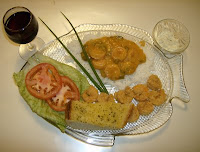Black-Eyed Peas
Ingredients
- 1 lb. dried black-eyed peas
- 2 slices of hickory smoked bacon
- 2 Tbsp onions, minced
- 2 Tbsp bell pepper, minced
- 1 tsp garlic, minced
- 1 tsp Colgin liquid smoke
- Water
- Salt and pepper to taste.
As is the case with thousands of other families across America, I also take part in the annual tradition of cooking-up a mess of black-eyed peas and cabbage in an effort to increase my luck for the coming New Year. Heaven knows we are gonna need all we can muster-up.
Contrary to popular belief, black-eyed peas don't have to be soaked over night or for any significant period of time because the peas have a thin skin and are relatively easy to cook.
Over medium (or lower) heat, black-eyed peas can be done in just a few minutes. It's the pot liquor that makes all the difference in how your peas will taste, however.
Think 'minced' and not 'chopped' when it comes to your vegetables. A couple tablespoons of minced onions and bell pepper - and about 1 teaspoon of minced garlic sautéed in the fat from a couple slices of smoked bacon creates a wonderful flavor and delicious taste. And, you can salt and pepper to your own liking.
Using a 2 quart pot begin by adding just enough water to cover the peas and sautéed vegetables by about an inch, (or by a finger and a half as we say in Cajun speak), and begin the slow process of cooking them to perfection, while stirring occasionally (around 1 - 1 1/2 hrs.). Keep an eye on the peas because you may have to add a little more water occasionally as they absorb and cook.You will know when they become tender enough by taste-testing.
Set them aside until the boiled cabbage is done.
A pound of dried black-eyed peas, when cooked, should yield between 5 and 6 cups.
Cabbage
Ingredients
- 1 head of cabbage, leaves separated
- 3 or 4 pork chops
- 2 Tbsp oil
- 1 Tbsp Colgin liquid smoke (hickory)
- 1 measure DIY Cajun Seasoning
- Additional salt and pepper (if desired)
Cooking cabbage (boiled) is also easy to do and the way I prepare my cabbage, by popular demand I might add, is to include 3 or 4 pork chops with it. This is how I prepare my boiled cabbage.
The first thing I do is to season the heck out of the pork chops with one measure of DIY Cajun Seasoning (easy to make - check it out), and fry them up in my cast-iron skillet on medium-high heat in a couple tablespoons of oil.
I fry the chops for a couple minutes on both sides until they are well browned, but I don't cook them all the way because they will finish cooking with the slow-boiling cabbage.
The next thing I do is get my kitchen shears and cut-up the chops into bite size pieces and add this to the boiling cabbage.
If you are using a heavy cast-iron skillet, chances are in your favor that a crust will form at the bottom of the skillet (it usually does when you cook meat fast on high heat).This is a good thing.
We Cajuns call this crusty material the 'gratin' - which is commonly used to compliment and enhance the flavor of various meat gravies.
Here's a little secret: keep the skillet hot but add in about 2 or 3 ice cubes and stir them around the skillet and they will magically loosen the crust (or 'gratin') and will produce a savory bouillon that you can add to the cabbage mixture to enhance the overall flavor.
Once you have liquefied the crust and added it to the stock pot along with the cabbage leaves and cut-up pork chops, you just go about your business of boiling cabbage like you always have (low and slow). Adding a little salt and black pepper always helps.
I like to also include a tablespoon of Colgin liquid smoke (hickory flavor) and not that other brand. Keep mixing and tumbling the cabbage leaves in the pot occasionally so they don't burn. The only difference with cooking cabbage this way instead of the traditional way is that you now have a delicious pot liquor and a few bites of meat to go with your good luck food.
See there! Your luck is already changing. Enjoy! Happy New Year! Ahheee!!










 About
About Tags
Tags Popular
Popular








